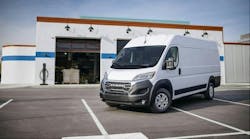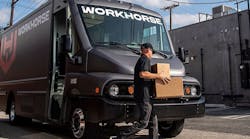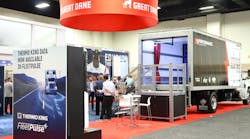There are some positive replacement trends in the dry van world, but the market is in “secular decline,” according to Thom Albrecht, president of Sword & Sea Transport Advisors LLC.
“Dry van loads have shrunk in nine of the last 14 years,” he said. “It’s really remarkable. We’re actually seeing trailers grow faster in 2015 through 2018 than the underlying load market. Did you know that in the last 14 years, dry van loads have grown as fast as 2% in just one year? We’re seeing tremendous shrinkage.
“There are three layers to that. Originally it was because of dramatic changes to product sizes. The most visible example is what’s happened to big-screen TVs. That’s an easy one. Then you had the packaging revolution, where all of a sudden all of the waste in terms of product size was taken out. I know of one plant that used to have 60 truckloads a week, and today it’s 54 just simply by changing the packaging. Then came the digitalization of products: books, music, videos. That’s all impacting freight. Today we’re dealing with e-commerce, which I believe is driving more LTL. I believe the van trailer market is in decay.”
Meanwhile, reefers are up 12.9% since 2013 and flatbeds are up 4.3%. In the next two years, reefers are forecast to go up 6.6% and flatbeds up 1%.
“The reefer market never did really retract,” he said. “We’ve seen steady growth. As you would expect, given the collapse in industrial production in ‘08 and ’09, and more recently in ‘15-‘16, we’ve seen a couple of periods where flatbed open deck has contracted a little. We’ve already seen in the spot market the dynamics for the flatbed load market have been improving much more this year than any other niche in the trucking world.
“Reefer loads were up 9.7% and trailers up 13.8% last year. I think that’s one reason why the market is a bit squishy in the reefer world today. But there are other things at work. Shortening length of hauls, more drop and hook, and increased reefer intermodal are driving much of this. We’re seeing a little bit of growth in the refrigerated intermodal market.”
He said the Food Safety Modernization Act (FSMA) is driving non-food reefer demand in some cases. Items now hauled temp-controlled that used to not be: aspirin and other pain tablets; sunscreen and suntan lotion; moisturizers; allergy tablets and gelcaps; scented air sprays; selected cleaning products; and baby lotions and adult facial creams; selected toothpastes and dental products; fiber supplements; furniture and car waxes; and selected baking ingredients.
“To me, the most important things to watch for are reefer demand and whether reefer carriers are doing well: How is the dry van spot market? You’re saying, ‘I thought we were talking about reefers.’ Well, with 20% to 25% of a typical reefer carrier loads, they turn the refrigerated unit off and they’re also competing in the dry van spot market. So as the dry market spot market stunk last year and a half, the performance of some of reefer carriers suffered as well.”
He presented a case study in reefer trailers: Marten Transport, which has added 1702 reefer trailers or 54% growth since 2004, but added fewer than 200 tractors—until 2015-2016, when 395 were added.
“Its length of haul fell 54% to 467 miles,” Albrecht said. “To do that, you need more trailers. So when I see reefers outpacing loads in the reefer world, I’m less concerned than I would be in flatbed or dry van because there are other dynamics there. Live loads and unloads have gone from 98% of shipments to 80%. About 20% of what they’re doing is drop and hook.”
He said the sharp downturn in platform/flatbeds loads in 2014-2015 was due to the bursting of the global commodity bubble, including oil, and the subsequent industrial production slump.
“Loads would have been worse, except for strength in construction, both commercial and residential,” he said. “With rig counts rising and industrial production rebounding, platform equipment should do well in 2017-2018. I think flatbeds are going to do pretty well. It’s not just energy, but the whole industrial climate is improving.”
He said that with flatbeds, the direction of industrial production (and energy prices) is key, along with residential and non-residential construction activity. He said it’s important to watch auto and aerospace, and farm income and commodity prices for ag and mining equipment.
Albrecht said disruptors are everywhere:
• There have been 4000 brick-and-mortar store closures so far in 2017. Even after 2017, at least 20% more brick-and-mortar stores will close in the next five to eight years.
• In 1990, Americans spent 5.2% of their income on apparel; today, it is just 3%.
• The US has an average of 48 square feet of retail per capita; the next highest nations are barely 20 square feet.
• Online sales are 9% of retail sales (15% when excluding gas and fast food) and are on the way to 30% or more.
• Amazon is pushing into food.
What does all this mean for freight and equipment?
Trucking disruptions:
• e-commerce: Fewer full truckloads.
• Transparency: compression of rates.
• Autonomous trucks: increased asset productivity, but more capacity, which is hurting rates.
• Electric vehicles: could lower per-mile costs.
“There is food disruption at the grocery level,” he said. “More shoppers are trying online grocery shopping and actually starting to buy.
“Amazon was just selected to be one of seven online retailers for a food stamp program serving 44 million people. Between that, online food spending, and the growth in meal-kit companies—Blue Apron, Plated, etc—big changes are coming. Food distribution will change. Traditional grocers that don’t adapt will be like today’s department stores. New winners and losers will emerge. Are you serving the food makers and sellers that will win the next five years?
His mega-trends:
• “The era of free labor and freight is coming to an end. Since the end of World War II, you and I have been the freight company. We pay the fuel bill. Every time we drove to Kroger, Target, or Walmart, we were the labor. We were the freight company. All of that is flipping around.”
• “The digital revolution has consumers impatient with the controlled experience with traditional stores.”
• “We are no longer willing to shop the way Target, Kroger, and others want us to shop.”
• “Purchasing ‘everyday’ commodities online is exploding, as are large, bulky items.”
• “Stores on wheels are coming to you. Remember how truckers talked about trailers as ‘inventories on wheels’? The next 10 years, your trailers are going to be stores on wheels.”
His predictions:
“Within three to five years, Amazon Prime will be same-day deliveries, not two-day. What do you think is going to happen? Now, 82% of the truckload length of hauls are under 500 miles. It’s probably going to be 82% of the loads are going to be under 250 miles.
“More smaller trucks and vans and fewer tractor-trailers. There’s going to be a massive increase in demand for medium-duty equipment because things are going to be coming from only 15 to 100 miles away. So the industry is going to be changing, so you have to embrace it.”
Albrecht also dissected the overall economic environment for 2017 and 2018.
His pros:
• Recovery in oil prices.
• Wage improvement to accelerate.
• Stable commodity prices after falling for two years. That will help production.
• Household debt is significantly lower than 2008-2009.
• Corporate investment to rise due to lower tax rates and repatriation of foreign earnings.
• Likely higher infrastructure spending.
• Inventories are in better shape.
• Likely reduction in individual marginal tax rates.
• More pragmatic regulatory environment.
Cons:
• Trade policies. “Are pragmatic changes forthcoming or protectionist policies that stifle trade? Plus, trade is a much more mature industry.”
• Strong dollar likely to crimp exports.
• Gasoline prices. If they rise to $3.10 to $3.25 a gallon, then consumer spending is likely to slow.
• Constraints on the labor force: While helpful for wages, GDP growth could be slower than expectations unless productivity surges.
• Rising interest rates could hamper housing. “But I don’t think there’s a threat over the next year and a half or so.”
• Auto and aerospace are already at peak/record levels.
He said that regardless of the election result last November, industrial production—which is so critical to freight creation and in turn to trailer demand—was going to recover.
“Since 1934, there have been only five periods in which industrial production contracted two years in a row. There has never been three years,” he said. “In the first quarter of this year, it grew 1.5%, the highest rate since the fourth quarter of 2014. Industrial production will modestly recover this year, resulting in more freight and tighter capacity.”
He said the bursting of the commodity bubble was behind the industrial production slump. Now it’s stable, and slightly rising commodity prices will help production and lift freight.
He said copper and wheat prices are a good example.
“Over a three- and four-year period, there was basically one direction—down,” he said. “But over the last several months, copper and wheat have stabilized. I’m not calling for a rip-roaring recovery. But earlier this week, Caterpillar’s revenue exceeded by over $700 million versus what people were looking for. They were almost $10 billion in the quarter. Just seeing commodity prices stabilize and modestly recover is good for industrial production because people aren’t going to mine copper just for the sake of it. They’re going to mine it because somebody wants to build something. Which flows right back into the trailer conversation.”
Other sectors:
• Drilling rig counts. “They are rising. The peak was May 2014. We’re way below the old peaks, but we’re up 100% over a year ago. There are more jobs, more steel, copper, and rubber, and more pumps, valves, rings, equipment, tools, etc. Hotel occupancy rates will rise in oil areas. Construction will recover in 2018 in oil areas.”
• Agriculture. “The outlook remains mixed. Farm income needs to reverse a four-year swoon. Tractor, combine, and farm implement sales will remain weak until this resumes growth, and that’s a negative for platform equipment. There is a decent livestock/protein outlook: cattle, pork, turkey, chicken. Expectations in 2017 are good for livestock trailers and ultimately reefer demand.”
• Housing. “Housing starts could accelerate from 5.6% growth in 2016 to 7% to 10% in 2017. Home builders have struggled with finding construction workers, not unlike trucking and drivers, so supply is not outpacing demand.”
• Global trade. “It will remain sluggish in 2017 until US actions are clear. Even with better trade deals, trade is more mature. Cheap labor markets have consistently been utilized. Outsourcing by the US is already large, so incremental growth is slower. Global supply chains are becoming somewhat more regionalized.” ♦












